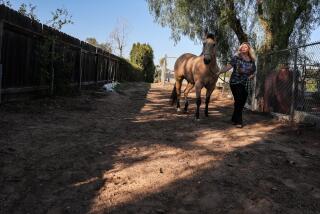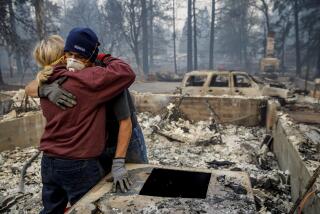Wholly willing to fight for Holy Jim

Deep in the Cleveland National Forest, down 4 1/2 miles of rocky road in a canyon surrounded by sheer walls and choked with dry brush and trees, Mike, George, Tom, Dave, Big John and Gertrude are prepared to confront Orange County’s Santiago fire.
The men are members of the Holy Jim Fire Department, about 20 volunteers in one of the most remote outposts fighting one of the worst Southern California wildfires. Gertrude is a 1947 pumper that earlier this week was in better condition than their other engine, which is only 30 years old.
The crew in Holy Jim Canyon is made up of mostly hikers and mountain bikers in their 40s and 50s who fell in love with the area’s rugged beauty but who live elsewhere. With so many fronts in the fire battle, they’re fully aware the cavalry may not be coming.
“There are primary fronts, secondary fronts, tertiary fronts -- and then there’s us,” said firefighter Rourke Oakland, 48. “There’s indefensible space. We’re undefendable.”
The Santiago fire has stalked the canyon all week. On Friday, flames chewed up the backcountry less than two miles away. A shift in wind threatened to overrun the community of 49 wood-and-rock cabins built in the 1920s on Forest Service land to expose city folk to the wonders of nature.
On a scale of 1 to 10, the fire danger in Holy Jim Canyon clocks in at about 20. Its narrow topography gives it the characteristics of a chimney. “Any fire that started here would come racing down this canyon at 50 mph,” said firefighter George Willis.
Sheriff’s deputies earlier in the week evacuated the canyon’s few full-time residents, including an 86-year-old woman with one leg and in poor health who was tricked by Fire Chief Michael Milligan.
“I got her out on a ruse,” Milligan said. “I told her she needed to go shopping.”
That left the volunteers. Their fire station is actually a fire barn, a sturdy forest green structure built in 1965. A disco ball hangs from the rafters. A shelf holds dusty metal canisters with training films from two generations ago, including such classics as “Nozzleman,” “Conflagration,” “Your Way Out” and “Breathing Apparatus -- Why?”
The operation runs on assessments paid by cabin owners, donations and hand-me-down equipment. (A fundraiser planned before the fires is scheduled for Nov. 3 at nearby Cook’s Corner.) Volunteers buy most of their personal gear, including fire-retardant suits and badges.
The crew members have enough food and water for several days. On Thursday, they worked on the fire engines, which, frankly needed work.
“Truck’s leaking fuel on the fuel line,” one of them said.
“Which one?” asked a comrade.
“Gertrude.”
“Damn.”
Despite her age, Gertrude pumps water like she’s doing the jitterbug. The other engine, though, is misfiring. The guys have the hood up and are attempting repairs. They pluck a dead mouse from the engine compartment. Someone asks whether anyone has seen the truck’s manual.
Make no mistake: The Holy Jim Fire Department is all business. One of their crew is a former professional, and they train once a month, lighting smoke bombs in metal buckets behind cabins and hustling to save them and their occupants.
“What I know about fighting fires comes from the experience of living here,” said Laura O’Reilly, 41, a cabin owner and the only woman in camp. “We’ve saved this canyon before.”
But no one is willing to give their life for the canyon. An evacuation plan is in place. Three blasts of a siren affixed to the barn is the signal to head for a nearby helicopter pad built for just such an emergency.
They have a 5,000-gallon water tank, and all of the cabins have smaller tanks that can be tapped. On the roadsides are boxes that store spring water. In normal years, water could be sucked directly from Trabuco Creek. This is not a normal year, however. Only 3 inches of rain fell in the past year, and the canyon is brittle, ready to ignite.
“We get knuckleheads back here who light up a fire, sit around and drink beer,” Oakland said. “We put them out really quickly.”
And they also make sure the knuckleheads get good and wet. “We get their license plate number and send them out of here,” Oakland said.
People have confronted flood and fire in Holy Jim ever since Jim Smith, a beekeeper known for his extraordinarily foul mouth, settled along Trabuco Creek in the 1880s. The worst in memory is a 1980 fire that swept through the surrounding forest and claimed several of Holy Jim’s cabins. A large black and white photo of the crew that fought back hangs in the fire barn.
“It was a god-awful thing that came screaming down that hill towards us,” said David Niederhaus, 66, who was fire chief at the time. “After it was done, the whole mountain was nothing but ash and dead animals.”
A former Marine helicopter pilot who lost an eye in Vietnam and goes by the nickname Cyclops, Niederhaus intends to protect his cabin again as a volunteer.
In 2004, he said, the Orange County Fire Authority responded in force to save four cabins from a blaze.
This time, with so many homes threatened across the region, Niederhaus understands why the canyon’s cabins aren’t a high priority.
Compared with other areas “there’s not much to lose up here,” Niederhaus said. “We’ve been told by the Forest Service that we’re on our own. But it’s good that they trust us to stay up here and do the right thing.”
As a thick tower of smoke rose above a ridge Friday, the Holy Jim crew settled in and waited. Gertrude was fixed, ready to roll.
Willis estimated that, in a worst-case scenario, they had six to eight hours’ worth of water if things got hot.
“That’s more than enough time for this area to burn out,” he said. “The fire departments call this an indefensible area. But we will defend it.”
More to Read
Start your day right
Sign up for Essential California for news, features and recommendations from the L.A. Times and beyond in your inbox six days a week.
You may occasionally receive promotional content from the Los Angeles Times.






